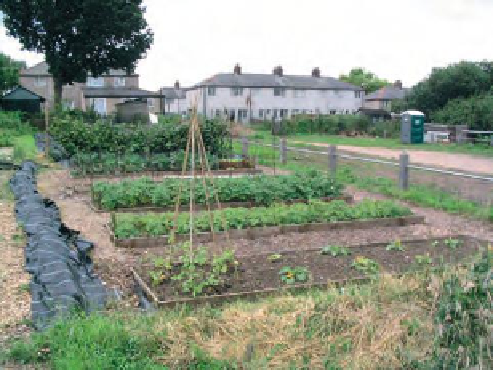Agriculture Reference
In-Depth Information
grey mould,
Fusarium
patch on turf and fireblight.
Adequate levels of
potassium
help to control fungal
diseases - for example,
Fusarium
wilt on plants such
as peas, tomatoes and carnation, and tomato mosaic
virus. Fertility provided by well-composted material
usually provides nutrients to the plant at the correct
concentrations.
Club root disease of brassicas is less damaging in
alkaline soil with a
pH
(see p. 174) greater than 6,
and lime may be incorporated before planting these
crops to achieve this aim. Gardeners apply
mulches
(e.g. composted bark, grass cuttings or straw), to bare
soil in order to control annual weeds by excluding the
source of light. Black polythene
sheeting
is used in
soft fruit to achieve a similar objective.
Risks
:
the use of increased levels of fertilizers to
grow bigger crops and dense turf may (particularly in
sandy
soils) lead to nutrients leaching into drains and
streams that may cause an increase in algae (
algal
bloom
) with poor water quality and death of fish in
streams and ponds.
Figure 16.4
Rotation plots used to reduce soil pests
and diseases
belonging to the same plant family fit into the rotation
system, because they have the same sensitivity to
the particular pest or disease. Potatoes, tomatoes,
peppers and aubergines are all members of the
Solanaceae family. Cabbages, cauliflowers, Brussels
sprouts, Chinese cabbage (and wallflowers) belong
to the Brassicaceae (see p. 56). When considering
a rotation plan, it is generally recommended that
the gardener restricts member species of the same
family to the same plot in the same growing season.
A commonly used
four-year rotation
would be as
follows: year 1, root crops such as carrots, beetroot
and parsnips; year 2, brassicas; year 3, potatoes,
celery, leeks and onions; year 4, peas and beans.
Rotation is
not
effective against pests and diseases
which are unspecific, such as grey mould (
Botrytis
),
which may attack a wide variety of plants
.
Rotation is
also not likely to be effective against rapidly spreading
airborne species such as greenfly and potato blight.
Risks
:
the
sclerotium
stage (see p. 252) of
white rot
disease (
Sclerotium cepivorum
) on onion and related
crop such as leeks, garlic, chives and shallots is an
especially difficult disease to deal with. It is able to
survive in the soil for 15 years or more. It can be seen
that a very long rotation period would be necessary to
remove this serious disease. A four-year rotation is not
normally sufficient.
Rotavating
16
Rotavating of soils enable a physical improvement in
soil structure
(see p. 147)
as a preparation for the
growing of crops. The improved drainage and tilth
may reduce damping-off diseases, disturb annual
and perennial weeds (e.g. chickweed and docks) and
expose soil pests (e.g. leather jackets and cutworms)
to the eager beaks of birds. Repeated rotavation may
be necessary to reduce the underground rhizomes
or taproots of perennial weeds such as couch grass.
Hoeing
annual weeds is an effective method,
provided the roots are fully exposed and the soil is dry
enough to prevent root re-establishment.
Crop rotation
Some important soil-borne pests and diseases attack
specific crops. For example, potato cyst nematode
(see p. 247) attack on potatoes and tomatoes, and club
root (see p. 256) on members of the cabbage family.
As these problems are soil borne, they are relatively
slow in their spread, but are difficult to control, largely
because they have a life-cycle stage that survives for
several years in the ground. By the simple method of
planting crops in different plots each year, this problem
survival stage is excluded from the sensitive crop
for a number of years, during which time the pest or
disease numbers will slowly decline (Figure 16.4).
A gardener often creates five or six plots (sometimes
bounded by wooden boarding) to isolate each
plot and thus achieve successful rotation. Crops
Planting and harvesting times
Some pests emerge from their overwintering stage
at about the same time each year (e.g.
cabbage
root fly
in late April). By planting early to establish
tolerant brassica plants before the pest emerges,
a useful cultural control is achieved. Similarly, the
deliberate planting of early potato cultivars enables


